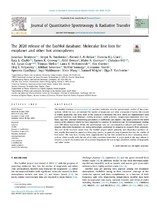| dc.description.abstract | The ExoMol database (www.exomol.com) provides molecular data for spectroscopic studies of hot atmospheres. While the data are intended for studies of exoplanets and other astronomical bodies, the dataset is widely applicable. The basic form of the database is extensive line lists; these are supplemented with partition functions, state lifetimes, cooling functions, Landé g-factors, temperature-dependent cross sections, opacities, pressure broadening parameters, k-coefficients and dipoles. This paper presents the latest release of the database which has been expanded to consider 80 molecules and 190 isotopologues totaling over 700 billion transitions. While the spectroscopic data are concentrated at infrared and visible wavelengths, ultraviolet transitions are being increasingly considered in response to requests from observers. The core of the database comes from the ExoMol project which primarily uses theoretical methods, albeit usually fine-tuned to reproduce laboratory spectra, to generate very extensive line lists for studies of hot bodies. The data have recently been supplemented by line lists derived from direct laboratory observations, albeit usually with the use of ab initiotransition intensities. A major push in the new release is towards accurate characterisation of transition frequencies for use in high resolution studies of exoplanets and other bodies. | en_US |

